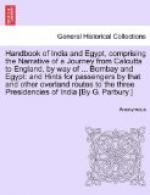* * * * *
Meanwhile there is some movement toward in the half-light of the inner room. From time to time you catch a glimpse of the black sphinx-faces, immobile and heavy-eyed, framed in scarves bearing a bold pattern of red monkeys and blue palm-trees: and as the din increases the owners of those inscrutable faces creep out and sink down upon a strip of china matting on the far side of the room. They are the wives and daughters of the community—some of them young and, from the Sidi point of view, good to look upon, others emulating the elephant in bulk, but all preternaturally solemn and immovable. Here and there among the faces you miss the well-known type. The thick prominent lips yield place to more delicate mouths, the shapeless nose to the slightly aquiline, for there are half-breeds here, who take more after their Indian fathers than their African mothers, and who serve as a living example of the tricks that Nature can play in the intermingling of races.
[Illustration: Sidis of Bombay.]
And now the piper in the corner sets up a wilder strain; the drummers work till their muscles crack, now looking as if they were undergoing torture, now turning half-round to have a joke with a fresh arrival, until the tension reaches breaking-point and with a shout some ten men dash forward and forming a ring round the musicians commence the wild “Bomo” dance, even as their savage ancestors were wont to do in past ages round the camp-fires of Africa. Watch them as they move round. They are obviously inspired by the noise and are bent heart and soul upon encouraging the laggards to join in, One of them, as he passes, shouts out that he sails by the P. and O. “Dindigul” the next day and intends to make a night of it; another is wearing the South African medal and says he earned it as fireman-serang on a troopship from these shores; while a third, in deference to the English guest, gives vent at intervals to a resonant “Hip, hip, Hurrah,” which almost drowns the unmelodious efforts of the “maestro” with the kerosine-tin. The “Bomo” dance is followed with scarce a pause by the “Lewa,” a kind of festal revel, in which the dancers move inwards and outwards as they circle round; and this in turn yields place to the “Bondogaya” and two religious figures, the “Damali” and “Chinughi,” which are said when properly performed to give men the power of divination.
Long ere the “Lewa” draws to a close, the women have joined in. First two of the younger women move from the corner, one of them with eyes half-closed and preserving a curious rigidity of body even while her feet are rythmically tapping the floor: then two more join and so on, until the circumference of the dancing-circle is expanded as far as the size of the room will allow and not a single woman is left on the china matting. Some of them are as completely under the spell of the music as the men, but they exhibit little sign of pleasure or excitement on their




